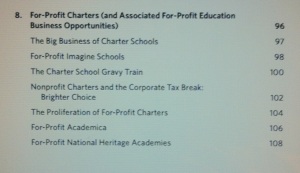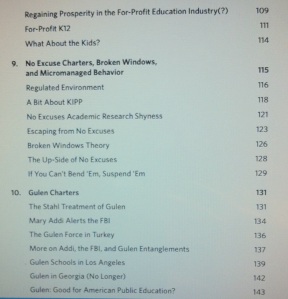Facing tough questions from Calif. officials, virtual charter school operator settles with attorney general | 89.3 KPCC:
Facing tough questions from Calif. officials, virtual charter school operator settles with attorney general
A national operator of online schools has agreed to pay $8.5 million in settlement costs and complete a long checklist of reforms at the 14 online charter schools it runs in California, all as part of a deal to close a long-running investigation by the state Attorney General’s office.
In exchange, the A.G.’s office will not pursue civil suits against that operator — Virginia-based K12, Inc. — and the California Virtual Academies on claims the schools falsely inflated their attendance numbers and made misleading claims about their course offerings, class sizes and student test scores.
Though a company spokesperson said K12 never expected repayment of these credits, officials with the A.G.’s office said they felt expunging these credits was an important step toward putting more distance between the for-profit K12 and the individual, non-profit CAVA schools.
“This settlement ensures K12 and its schools are held accountable and make much-needed improvements,” said California Attorney General Kamala Harris in a statement, which also noted K12 had cooperated with the state’s inquiry.
More than 13,000 students attend California Virtual Academies. Different school districts across the state hold the charters for each individual CAVA school; for instance, the West Covina Unified School District authorizes the two L.A. County-based virtual campuses, which enroll a combined total of 3,700 kids.
But each of these individual non-profit entities has a curriculum provider and administrative office in common: K12, Inc. The company furnished everything necessary for students to attend courses and complete assignments entirely online.
In 2012, a whistleblower alleged CAVA teachers were fudging attendance records, counting students who’d logged in for as little as one minute as being present for a full day. This, the attorney general’s office alleged, had the effect of inflating the schools’ funding, since in California, daily attendance determines a school’s funding level.
As part of Friday's settlement, K12 and the CAVA schools agreed to several fixes designed to ensure teachers accurately record attendance and account for students' learning time. They also agreed to remedy a litany of other problems unearthed in the California Department of Justice's lengthy investigation. A few of them:
- The California Virtual Academies will hire a third-party expert to review and recommend changes to the schools' special education policies. The schools must create a staff training program to "ensure effective understanding of legal requirements related to delivery of special education services."
- The schools will correct several claims on CAVA websites and in advertisements and that the A.G. described as misleading. (They had said CAVA's public communications included inflated statistics about the growth in students' academic test scores, claims that parent satisfaction rates exceeded 94 percent when they were in fact lower; and false advertisements for class sizes ranging between 15 and 20 pupils, when in actuality, class sizes occasionally topped 30 students.)
- CAVA schools will provide a $20 subsidy each month to each household to help pay for access to high-speed internet.
- "To ensure an arms-length relationship between the not-for-profit CAVA schools and the for-profit education management company," each school will adopt conflicts of interest policies preventing K12 employees or their family members from holding seats on the boards of any individual California Virtual Academy. K12 officials will also remove themselves from check writing authority from CAVA schools' bank accounts.
In a statement, a spokesperson for the California Charter Schools Association condemned what she termed "the predatory and dishonest practices employed by K12, Inc. to dupe parents using misleading marketing schemes, siphon taxpayer dollars with inflated student attendance data, and coerce CAVA School nonprofit employees into dubious contracting arrangements."
But K12 CEO Stuart Udell pushed back in a written statement of his own, pointing out the settlement did not include a statement of fault or wrongdoing from either the company or the individual schools.
"Opponents of K12 and skeptics of public online education have spent years making wild, attention-grabbing charges about us and our business,” Udell. “The State of California used the full authority and investigative resources of the Office of the Attorney General to investigate these charges for over eight months. In the end, we demonstrated industry leading levels of service and compliance with regulations and benefits to families."
Of K12's $8.5 million total settlement payout, $6 million will reimburse the state for the costs of its investigation.

























